11 The Fungi Kingdom
By the end of this chapter, you will be able to:
- Describe the characteristics of members of the fungi kingdom
- Explain how fungi sexually reproduce
- Describe the roles fungi play in their environment
- Describe the composition of the mycelium
- Describe the mode of nutrition of fungi
- Identify fungi and place them into the five major phyla according to current classification
- Describe each phylum in terms of major representative species and patterns of reproduction
Introduction
The word fungus comes from the Latin word for mushrooms. Indeed, the familiar mushroom is a reproductive structure used by many types of fungi. However, there are also many fungus species that don’t produce mushrooms at all. Being eukaryotes, a typical fungal cell contains a true nucleus and many membrane-bound organelles. The kingdom Fungi includes an enormous variety of living organisms collectively referred to as Eucomycota, or true Fungi (Fig 1). While scientists have identified about 100,000 species of fungi, this is only a fraction of the 1.5 million species of fungus likely present on Earth. Edible mushrooms, yeasts, black mold, and the producer of the antibiotic penicillin, Penicillium notatum, are all members of the kingdom Fungi, which belongs to the domain Eukarya.
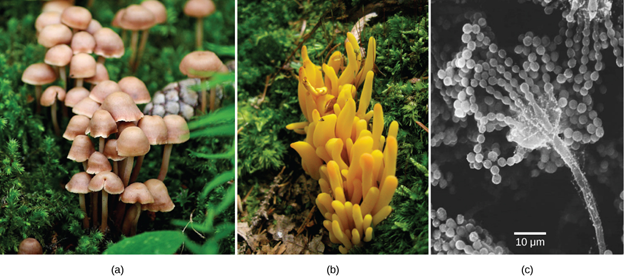
Figure 1: Many species of fungus produce the familiar mushroom (a) which is a reproductive structure. This (b) coral fungus displays brightly colored fruiting bodies. This electron micrograph shows (c) the spore-bearing structures of Aspergillus, a type of toxic fungus found mostly in soil and plants. (credit “mushroom”: modification of work by Chris Wee; credit “coral fungus”: modification of work by Cory Zanker; credit “Aspergillus”: modification of work by Janice Haney Carr, Robert Simmons, CDC; scale-bar data from Matt Russell)
Fungi, once considered plant-like organisms, are more closely related to animals than plants. Fungi are not capable of photosynthesis: they are heterotrophic because they use complex organic compounds as sources of energy and carbon. Fungi share a few other traits with animals. Their cell walls are composed of chitin, which is found in the exoskeletons of arthropods. Fungi produce a number of pigments, including melanin, also found in the hair and skin of animals. Like animals, fungi also store carbohydrates as glycogen. However, like bacteria, fungi absorb nutrients across the cell surface and act as decomposers, helping to recycle nutrients by breaking down organic materials to simple molecules.
Some fungal organisms multiply only asexually, whereas others undergo both asexual reproduction and sexual reproduction. Most fungi produce a large number of spores, which are haploid cells that can undergo mitosis to form multicellular, haploid individuals.
Fungi often interact with other organisms, forming beneficial or mutualistic associations. For example, most terrestrial plants form symbiotic relationships with fungi. The roots of the plant connect with the underground parts of the fungus, which form mycorrhizae. Through mycorrhizae, the fungus and plant exchange nutrients and water, greatly aiding the survival of both species. Alternatively, lichens are an association between a fungus and its photosynthetic partner (usually an alga). Here the fungus houses the algae and the algae provides extra photosynthetic product for the fungus. Both species gain in this relationship (Fig 2).

Figure 2: Lichen, the mutualistic relationship between a species of fungus and a species of algae. Some lichen grow on trees and rocks, while others are more independent, often seen on forest floors. Lichen also have different forms associated with them evidenced in this photo. Lichen on headstone by Derek Mayes, Wikimedia Commons.
Fungi also cause serious infections in plants and animals. For example, Dutch elm disease, which is caused by the fungus Ophiostoma ulmi, is a particularly devastating type of fungal infestation that destroys many native species of elm (Ulmus sp.) by infecting the tree’s vascular system. The elm bark beetle acts as a vector, transmitting the disease from tree to tree. Accidentally introduced in the 1900s, the fungus decimated elm trees across the continent. Many European and Asiatic elms are less susceptible to Dutch elm disease than American elms.
In humans, fungal infections are generally considered challenging to treat. Unlike bacteria, fungi do not respond to traditional antibiotic therapy, since they are eukaryotes. Fungal infections may prove deadly for individuals with compromised immune systems.
Fungi have many commercial applications. The food industry uses yeast in baking, brewing, and cheese, and winemaking. Many industrial compounds are byproducts of fungal fermentation. Fungi are the source of many commercial enzymes and antibiotics (mycomedicine).
Watch the following short video on the “Human Uses of Fungi”.
Cell Structure and Function
Fungi are eukaryotes, and as such, have a complex cellular organization with a nucleus and other membrane-bound organelles in their cells. As eukaryotes, fungal cells contain a membrane-bound nucleus. The DNA in the nucleus is wrapped around histone proteins, as is observed in other eukaryotic cells. A few types of fungi have accessory genomic structures comparable to bacterial plasmids (loops of DNA); however, the horizontal transfer of genetic information that occurs between one bacterium and another rarely occurs in fungi. Fungal cells also contain mitochondria and a complex system of internal membranes, including the endoplasmic reticulum and Golgi apparatus.
Unlike plant cells, fungal cells do not have chloroplasts or chlorophyll. Many fungi display bright colors arising from other cellular pigments, ranging from red to green to black. The poisonous Amanita muscaria (fly agaric) is recognizable by its bright red cap with white patches (Fig 3). Pigments in fungi are associated with the cell wall and play a protective role against ultraviolet radiation. Some fungal pigments are toxic to humans.
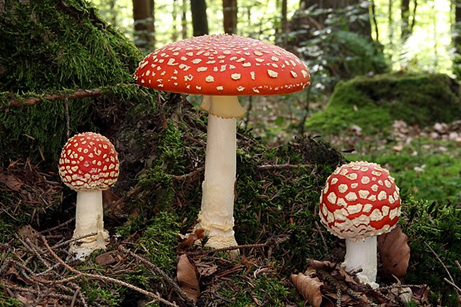
Figure 3: Amanita muscaria is native to temperate and boreal regions of North American and is poisonous. Holger Krisp, CC via Wikimedia Commons.
Like plant cells, fungal cells have a thick cell wall. The rigid layers of fungal cell walls contain complex polysaccharides called chitin and glucans. Chitin, a long-chain polymer/polysaccharides, also found in the exoskeleton of arthropods such as insects, gives structural strength to the cell walls of fungi. The wall protects the cell from desiccation and some predators. Fungi have plasma membranes similar to those of other eukaryotes, except that the structure is stabilized by ergosterol, a steroid molecule that replaces the cholesterol found in animal cell membranes. Most members of the kingdom Fungi are nonmotile; however, flagella are produced by the spores and gametes in the primitive Phylum Chytridiomycota.
Growth
The vegetative body of a fungus is a unicellular or multicellular thallus. Unicellular fungi are called yeasts. Multicellular fungi produce threadlike hyphae (singular hypha). Dimorphic fungi can change from the unicellular to multicellular state depending on environmental conditions. Saccharomyces cerevisiae (baker’s yeast) and Candida species (the agents of thrush, a common fungal infection) are examples of unicellular fungi (Fig 4).
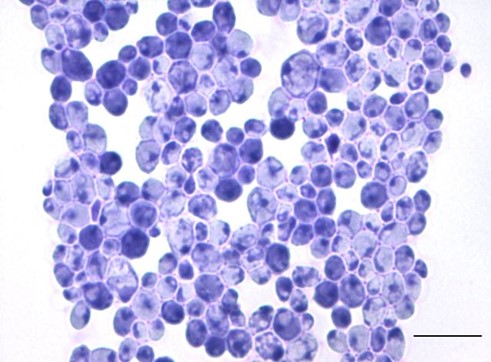
Figure 4: Candida albicans is a yeast cell and the agent of candidiasis and thrush. This organism is unicellular, which is less common for fungi, but is still eukaryotic (note the nucleus as the darker smaller purple structure inside the cell). The scale is 0.01mm. Jon Houseman, CC , via Wikimedia Commons.
Most fungi are multicellular organisms. They display two distinct morphological stages: the vegetative and reproductive. The vegetative stage consists of a tangle of hyphae, whereas the reproductive stage can be more conspicuous. The mass of hyphae is a mycelium (Fig 5). It can grow on a surface, in soil or decaying material, in a liquid, or even on living tissue. Although individual hyphae must be observed under a microscope, the mycelium of a fungus can be very large, with some species truly being “the fungus humongous.” The giant Armillaria solidipes (honey mushroom) is considered the largest organism on Earth, spreading across more than 2,000 acres of underground soil in eastern Oregon; it is estimated to be at least 2,400 years old.
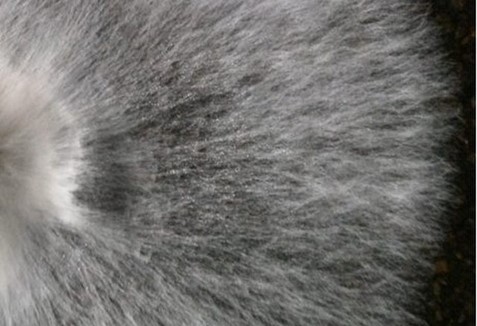
Figure 5: Pleurotus ostreatus fungi mycelium on coffee grounds. Tobi Kellner, CC , via Wikimedia Commons.
Most fungal hyphae are divided into separate cells by septa (singular, septum) (Fig 6a, c). In most phyla of fungi, tiny holes in the septa allow for the rapid flow of nutrients and small molecules from cell to cell along the hypha. They are described as perforated septa. The hyphae in bread molds (which belong to the Phylum Zygomycota) are not separated by septa. Instead, they are formed by large cells containing many nuclei (multinucleate), an arrangement described as coenocytic hyphae.
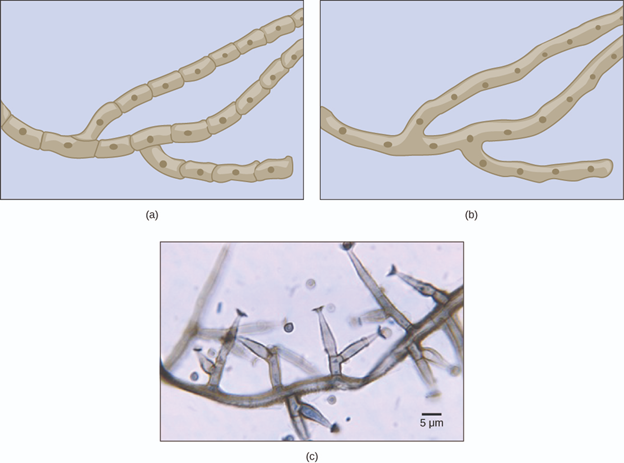
Figure 6: Fungal hyphae. Fungal hyphae may be (a) septated or (b) coenocytic (coeno- = “common”; -cytic = “cell”) with many nuclei present in a single hypha. A bright field light micrograph of (c) Phialophora richardsiae shows septa that divide the hyphae. (credit c: modification of work by Dr. Lucille Georg, CDC; scale-bar data from Matt Russell)
Fungi thrive in environments that are moist and slightly acidic, and can grow with or without light. They vary in their oxygen requirement. Most fungi are obligate aerobes, requiring oxygen to survive. Other species, such as members of the Chytridiomycota that reside in the rumen of cattle, are obligate anaerobes, in that they only use anaerobic respiration because oxygen will disrupt their metabolism or kill them. Yeasts are intermediate, being facultative anaerobes. This means that they grow best in the presence of oxygen using aerobic respiration, but can survive using anaerobic respiration when oxygen is not available. The alcohol produced from yeast fermentation is used in wine and beer production.
Like animals, fungi are heterotrophs; they use complex organic compounds as a source of carbon, rather than fix carbon dioxide from the atmosphere as do some bacteria and most plants. In addition, fungi do not fix nitrogen from the atmosphere. Like animals, they must obtain it from their diet. However, unlike most animals, which ingest food and then digest it internally in specialized organs, fungi perform these steps in the reverse order; digestion precedes ingestion. First, exoenzymes are transported out of the hyphae, where they process nutrients in the environment. Then, the smaller molecules produced by this external digestion are absorbed through the large surface area of the mycelium. As with animal cells, the polysaccharide of storage is glycogen, a branched polysaccaride, rather than amylopectin, a less densely branched polysaccharide, and amylose, a linear polysaccharide, as found in plants.
Fungi are mostly saprobes (saprophyte is an equivalent term): organisms that derive nutrients from decaying organic matter. They obtain their nutrients from dead or decomposing organic material derived mainly from plants. Fungal exoenzymes are able to break down insoluble compounds, such as the cellulose and lignin of dead wood, into readily absorbable glucose molecules. The carbon, nitrogen, and other elements are thus released into the environment. Because of their varied metabolic pathways, fungi fulfill an important ecological role and are being investigated as potential tools in bioremediation of chemically damaged ecosystems. For example, some species of fungi can be used to break down diesel oil and polycyclic aromatic hydrocarbons (PAHs). Other species take up heavy metals, such as cadmium and lead.
Some fungi are parasitic, infecting either plants or animals. Smut and Dutch elm disease affect plants, whereas athlete’s foot and candidiasis (thrush) are medically important fungal infections in humans. In environments poor in nitrogen, some fungi resort to predation of nematodes (small non-segmented roundworms). In fact, species of Arthrobotrys fungi have a number of mechanisms to trap nematodes: One mechanism involves constricting rings within the network of hyphae. The rings swell when they touch the nematode, gripping it in a tight hold. The fungus then penetrates the tissue of the worm by extending specialized hyphae called haustoria. Many parasitic fungi possess haustoria, as these structures penetrate the tissues of the host, release digestive enzymes within the host’s body, and absorb the digested nutrients.
Watch the “Fantastic Fungi Film Time Lapses” by Stephen Axford.
Reproduction
Fungi reproduce sexually and/or asexually. Perfect fungi reproduce both sexually (using meiosis) and asexually, while the so-called imperfect fungi reproduce only asexually (by mitosis). Sexual reproduction means that the process of meiosis is used to reduce the ploidy of a cell from diploid (two copies of DNA) to haploid (one copy of DNA). Fungi will do this when a reproductive structure, a sporangium, undergoes meiosis to produce haploid spores.
In both sexual and asexual reproduction, fungi produce spores that disperse from the parent organism by either floating on the wind or hitching a ride on an animal. Fungal spores are smaller and lighter than plant seeds. For example, the giant puffball mushroom bursts open and releases trillions of spores in a massive cloud of what looks like finely particulate dust. The huge number of spores released increases the likelihood of landing in an environment that will support growth (Fig 7).
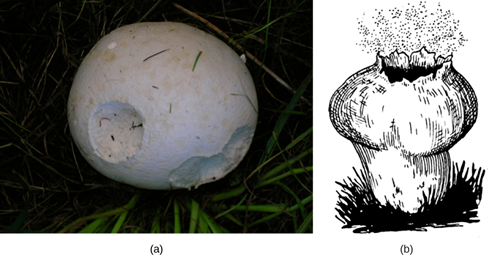
Figure 7: Puffball and spores. The (a) giant puffball mushroom releases (b) a cloud of spores when it reaches maturity. (credit a: modification of work by Roger Griffith; credit b: modification of work by Pearson Scott Foresman, donated to the Wikimedia Foundation)
Fungi reproduce asexually by fragmentation, budding, or producing spores. Fragments of hyphae can grow new colonies. Somatic cells (non-reproducing cells) in yeast form buds. During budding (an expanded type of cytokinesis or cytoplasmic division), a bulge forms on the side of the cell, the nucleus divides mitotically, and the bud ultimately detaches itself from the mother cell (original cell).
The most common mode of asexual reproduction is through the formation of asexual spores, which are produced by a single individual thallus (through mitosis) and are genetically identical to the parent thallus (Fig 8). Spores allow fungi to expand their distribution and colonize new environments. They may be released from the parent thallus either outside or within a special reproductive sac called a sporangium.
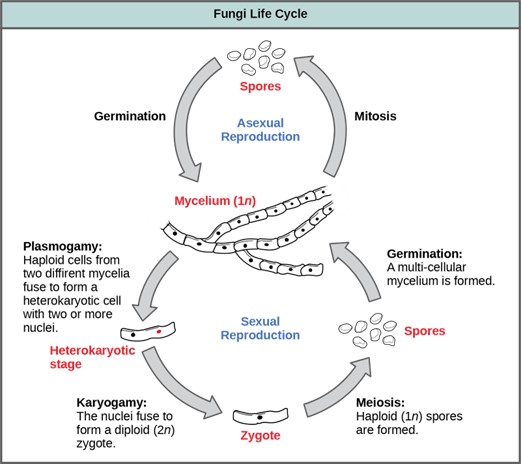
Figure 8: Generalized fungal life cycle. Fungi may have both asexual and sexual stages of reproduction.
There are many types of asexual spores. Conidiospores are unicellular or multicellular spores that are released directly from the tip or side of the hypha. Other asexual spores originate in the fragmentation of a hypha to form single cells that are released as spores; some of these have a thick wall surrounding the fragment. Yet others bud off the vegetative parent cell. In contrast to conidiospores, sporangiospores are produced directly from a sporangium (Fig 9).
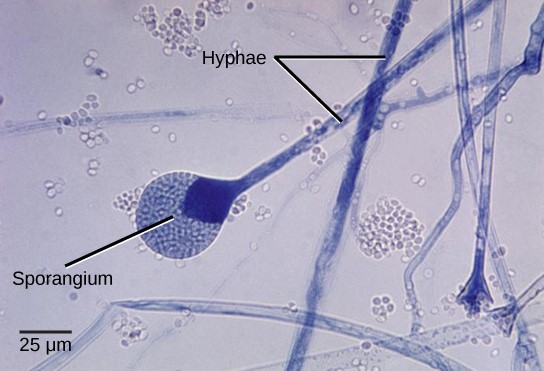
Figure 9: Sporangiospores. This micrograph shows the release of spores from a sporangium at the end of a hyphae called a sporangiophore. The organism is a Mucor sp. Fungus, a mold often found indoors. (credit: modification of work by Dr. Lucille Georg, CDD; scale-bar data from Matt Russell)
Because fungal cells are haploid, before sexual reproduction and meiosis begins, union of these haploid cells must occur. During sexual reproduction, two mating types called “+” and “-” will unite and fuse together. When both mating types are present in the same mycelium, it is called homothallic, or self-fertile. Heterothallic mycelia require two different, but compatible, mycelia to reproduce sexually.
Although there are many variations in fungal sexual reproduction, all include the following three stages (Fig 8). First, during plasmogamy (literally, “marriage or union of cytoplasm”), two haploid cells fuse, leading to a dikaryotic stage where two haploid nuclei coexist in a single cell. During karyogamy (“nuclear marriage”), the haploid nuclei fuse to form a diploid zygote nucleus. Finally, meiosis takes place in the gametangia (singular, gametangium) organs, in which gametes of different mating types are generated. At this stage, spores are disseminated into the environment.
Below is a helpful review video on the characteristics of Fungi.
Classification of Fungi
The kingdom Fungi contains five major phyla that were established according to their mode of sexual reproduction or using molecular data. Polyphyletic, unrelated fungi that reproduce without a sexual cycle, were once placed for convenience in a sixth group, the Deuteromycota, called a “form phylum,” because superficially they appeared to be similar. However, most mycologists have discontinued this practice. Rapid advances in molecular biology and the sequencing of 18S rRNA (ribosomal RNA) continue to show new and different relationships among the various categories of fungi.
The five true phyla of fungi are the Chytridiomycota (Chytrids), the Zygomycota (conjugated fungi), the Ascomycota (sac fungi), the Basidiomycota (club fungi) and the recently described Phylum Glomeromycota (Fig 10).
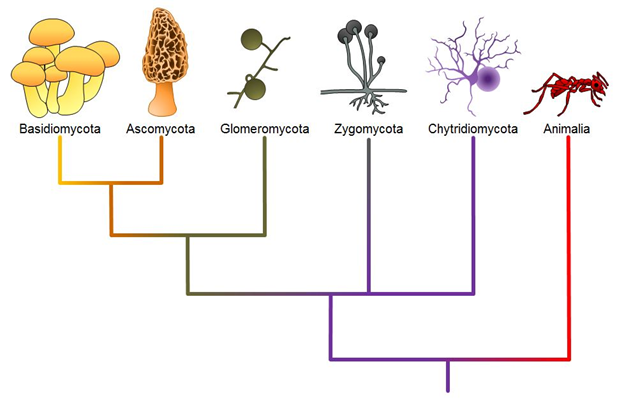
Figure 10: Fungal phyla. Note “mycota” is used to designate a phylum while “mycetes” formally denotes a class or is used informally t refer to all members of the phylum
Chytridiomycota: The Chytrids
The only class in the Phylum Chytridiomycota is the Chytridiomycetes. The chytrids are the simplest and most primitive Eumycota, or true fungi. The evolutionary record shows that the first recognizable chytrids appeared during the late pre-Cambrian period, more than 500 million years ago. Like all fungi, chytrids have chitin in their cell walls, but one group of chytrids has both cellulose and chitin in the cell wall. Most chytrids are unicellular; however, a few form multicellular organisms and hyphae, which have no septa between cells (coenocytic). The Chytrids are the only fungi that have retained flagella. They produce both gametes and diploid zoospores that swim with the help of a single flagellum. An unusual feature of the chytrids is that both male and female gametes are flagellated.
The ecological habitat and cell structure of chytrids have much in common with protists. Chytrids usually live in aquatic environments, although some species live on land. Some species thrive as parasites on plants, insects, or amphibians, while others are saprobes. The chytrid species Allomyces is well characterized as an experimental organism. Its reproductive cycle includes both asexual and sexual phases. Allomyces produces diploid or haploid flagellated zoospores in a sporangium.
Zygomycota: The Conjugated Fungi
The zygomycetes are a relatively small group of fungi belonging to the Phylum Zygomycota. They include the familiar bread mold, Rhizopus stolonifer, which rapidly propagates on the surfaces of breads, fruits, and vegetables (Fig 11). Most species are saprobes, living off decaying organic material; a few are parasites, particularly of insects. Zygomycetes play a considerable commercial role. For example, the metabolic products of some species of Rhizopus are intermediates in the synthesis of semi-synthetic steroid hormones.
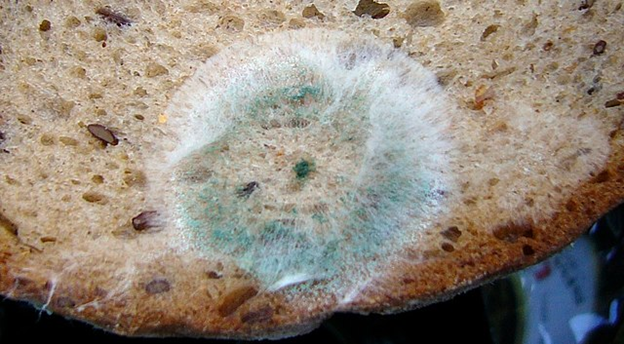
Figure 11: Bread mold growing on a piece of bread. User:Mattes, Public domain, via Wikimedia Commons. https://commons.wikimedia.org/wiki/File:Brot-Schimmel.JPG
Zygomycetes have a thallus of coenocytic hyphae in which the nuclei are haploid when the organism is in the vegetative stage. The fungi usually reproduce asexually by producing sporangiospores. The black tips of bread mold are the swollen sporangia packed with black spores. When spores land on a suitable substrate, they germinate and produce a new mycelium. Sexual reproduction starts when environmental conditions become unfavorable. Two opposing mating strains (type + and type –) must be in close proximity for gametangia from the hyphae to be produced and fuse, leading to karyogamy. Each zygospore can contain several diploid nuclei. The developing diploid zygospores have thick coats that protect them from desiccation and other hazards. They may remain dormant until environmental conditions are favorable. When the zygospore germinates, it undergoes meiosis and produces haploid spores, which will, in turn, grow into a new organism. This form of sexual reproduction in fungi is called conjugation (although it differs markedly from conjugation in bacteria and protists), giving rise to the name “conjugated fungi”.
Ascomycota: The Sac Fungi
The majority of known fungi belong to the Phylum Ascomycota, which is characterized by the formation of an ascus (plural, asci), a sac-like structure that contains haploid ascospores. Filamentous ascomycetes produce hyphae divided by perforated septa, allowing streaming of cytoplasm from one cell to another. Conidia and asci, which are used respectively for asexual and sexual reproduction, are usually separated from the vegetative hyphae by blocked (non-perforated) septa. Many ascomycetes are of commercial importance. Some play a beneficial role for humanity, such as the yeasts used in baking, brewing, and wine fermentation, and directly as food delicacies such as truffles and morels. Aspergillus oryzae is used in the fermentation of rice to produce sake. Other ascomycetes parasitize plants and animals, including humans. For example, fungal pneumonia poses a significant threat to AIDS patients who have a compromised immune system. Ascomycetes not only infest and destroy crops directly; they also produce poisonous secondary metabolites that make crops unfit for consumption.
Asexual reproduction is frequent and involves the production of conidiophores that release haploid conidiospores. Sexual reproduction starts with the development of special hyphae from either one of two types of mating strains. The “male” strain produces an antheridium and the “female” strain develops an ascogonium. At fertilization, the antheridium and the ascogonium combine in plasmogamy, without nuclear fusion. Special dikaryotic ascogenous (ascus-producing) hyphae arise from this dikaryon, in which each cell has pairs of nuclei: one from the “male” strain and one from the “female” strain. In each ascus, two haploid nuclei fuse in karyogamy. Thousands of asci fill a fruiting body called the ascocarp. The diploid nucleus in each ascus gives rise to haploid nuclei by meiosis, and spore walls form around each nucleus. The spores in each ascus contain the meiotic products of a single diploid nucleus. The ascospores are then released, germinate, and form hyphae that are disseminated in the environment and start new mycelia.
Basidiomycota: The Club Fungi
The fungi in the Phylum Basidiomycota are easily recognizable under a light microscope by their club-shaped fruiting bodies called basidia (singular, basidium), which are the swollen terminal cells of hyphae. The basidia, which are the reproductive organs of these fungi, are often contained within the familiar mushroom, commonly seen in fields after rain, on the supermarket shelves, and growing on your lawn. These mushroom-producing basidiomycetes are sometimes referred to as “gill fungi” because of the presence of gill-like structures on the underside of the cap. The gills are actually compacted hyphae on which the basidia are borne. This group also includes shelf fungi, which cling to the bark of trees like small shelves. In addition, the basidiomycota include smuts and rusts, which are important plant pathogens. Most edible fungi belong to the Phylum Basidiomycota; however, some basidiomycota are inedible and produce deadly toxins. For example, Cryptococcus neoformans causes severe respiratory illness. The infamous death cap mushroom (Amanita phalloides) is related to the fly agaric seen earlier in this chapter.
The lifecycle of basidiomycetes includes sexual and asexual reproduction. Most fungi are haploid through most of their life cycles, but the basidiomycetes produce both haploid and dikaryotic mycelia, with the dikaryotic phase being dominant. (Note: The dikaryotic phase is technically not diploid, since the nuclei remain unfused until shortly before spore production.) In the basidiomycetes, sexual spores are more common than asexual spores. The sexual spores form in the club-shaped basidium and are called basidiospores. In the basidium, nuclei of two different mating strains fuse (karyogamy), giving rise to a diploid zygote that then undergoes meiosis. The haploid nuclei migrate into four different chambers appended to the basidium, and then become basidiospores.
Each basidiospore germinates and generates monokaryotic haploid hyphae. The mycelium that results is called a primary mycelium. Mycelia of different mating strains can combine and produce a secondary mycelium that contains haploid nuclei of two different mating strains. This is the dominant dikaryotic stage of the basidiomycete life cycle. Thus, each cell in this mycelium has two haploid nuclei, which will not fuse until formation of the basidium. Eventually, the secondary mycelium generates a basidiocarp, a fruiting body that protrudes from the ground—this is what we think of as a mushroom. The basidiocarp bears the developing basidia on the gills under its cap.
So, basidiomycetes primarily reproduce sexually through the formation of basidia, specialized club-shaped structures that produce haploid spores called basidiospores. These basidiospores are formed on the surface of basidia and are released from the basidium to disperse and germinate under favorable conditions to produce new mycelium.
Basidiomycota do not have a well-developed asexual reproductive phase involving the production of conidia, which is more common in other fungal groups like Ascomycota.
Asexual Ascomycota and Basidiomycota
Imperfect fungi—those that do not display a sexual phase—were formerly classified in the form phylum Deuteromycota, an invalid taxon no longer used in the present, ever-developing classification of organisms. While Deuteromycota was once a classification taxon, recent molecular analysis has shown that some of the members classified in this group belong to the Ascomycota or the Basidiomycota. Because some members of this group have not yet been appropriately classified, they are less well described in comparison to members of other fungal taxa. Most imperfect fungi live on land, with a few aquatic exceptions. They form visible mycelia with a fuzzy appearance and are commonly known as mold.
The fungi in this group have a large impact on everyday human life. The food industry relies on them for ripening some cheeses. The blue veins in Roquefort cheese and the white crust on Camembert are the result of fungal growth. The antibiotic penicillin was originally discovered on an overgrown Petri plate, on which a colony of Penicillium fungi had killed the bacterial growth surrounding it. Other fungi in this group cause serious diseases, either directly as parasites (which infect both plants and humans), or as producers of potent toxic compounds, as seen in the aflatoxins released by fungi of the genus Aspergillus.
Glomeromycota
The Glomeromycota is a newly established phylum that comprises about 230 species, all of which are involved in close associations with the roots of trees. Fossil records indicate that trees and their root symbionts share a long evolutionary history. It appears that nearly all members of this family form arbuscular mycorrhizae: the hyphae interact with the root cells forming a mutually beneficial association in which the plants supply the carbon source and energy in the form of carbohydrates to the fungus, and the fungus supplies essential minerals from the soil to the plant. The exception is Geosiphon pyriformis, which hosts the cyanobacterium Nostoc as an endosymbiont.The glomeromycetes do not reproduce sexually and do not survive without the presence of plant roots. Although they have coenocytic hyphae like the zygomycetes, they do not form zygospores. DNA analysis shows that all glomeromycetes probably descended from a common ancestor, making them a monophyletic lineage.
Summary
The chapter on fungi delves into the diverse and fascinating world of these eukaryotic organisms, which comprise the kingdom Fungi. Fungi are an incredibly varied group, ranging from microscopic single-celled yeasts to vast, interconnected mycelial networks, exemplified by the towering mushrooms that dot forests and fields. This chapter explores the key characteristics, life cycle, ecological roles, and interactions of fungi in the natural world.
The chapter begins by introducing the fundamental traits of fungi, including their cell structure, lack of chlorophyll, and unique mode of nutrition. As heterotrophs, fungi obtain nutrients through absorption, breaking down complex organic matter into simpler compounds with the help of enzymes secreted by their hyphal structures. This ability makes them essential decomposers, playing a crucial role in nutrient cycling and ecosystem functioning.
The life cycle of fungi is highlighted, emphasizing the significance of both sexual and asexual reproduction. Sexual reproduction often involves the fusion of hyphae from different mating types, leading to the formation of specialized reproductive structures like basidia and asci, which produce sexual spores for dispersal. Asexual reproduction is also explored, with some fungi forming spores like conidia for efficient dissemination.
Fungi’s ecological importance is emphasized throughout the chapter, as they participate in various symbiotic relationships with other organisms. Mycorrhizal associations with plant roots enhance nutrient uptake and provide mutual benefits, while lichens showcase a unique partnership between fungi and algae or cyanobacteria. Additionally, fungi interact with a multitude of other organisms, serving as pathogens of plants and animals, as well as endophytes that promote the health and resilience of their hosts.
The chapter also reminds us of the economic significance of fungi. Many fungi are of great value to humans, as sources of food, medicine, and industrial products. Conversely, certain species are responsible for destructive plant diseases and food spoilage..
Organisms in the Fungi kingdom exhibit vast diversity and essential ecological roles. From their vital role in nutrient cycling and decomposition to their complex symbiotic associations and intriguing life cycles, fungi are a kingdom of extraordinary adaptability and importance in the natural world and human society alike.
Questions
Glossary
References
Clark, MA, Choi, J, and Douglasm, M. Biology 2e for Biol 111 and Biol 112. St. Francis Xavier University.
Kosal, E. 2023. Summary on Fungi. NC State University.

